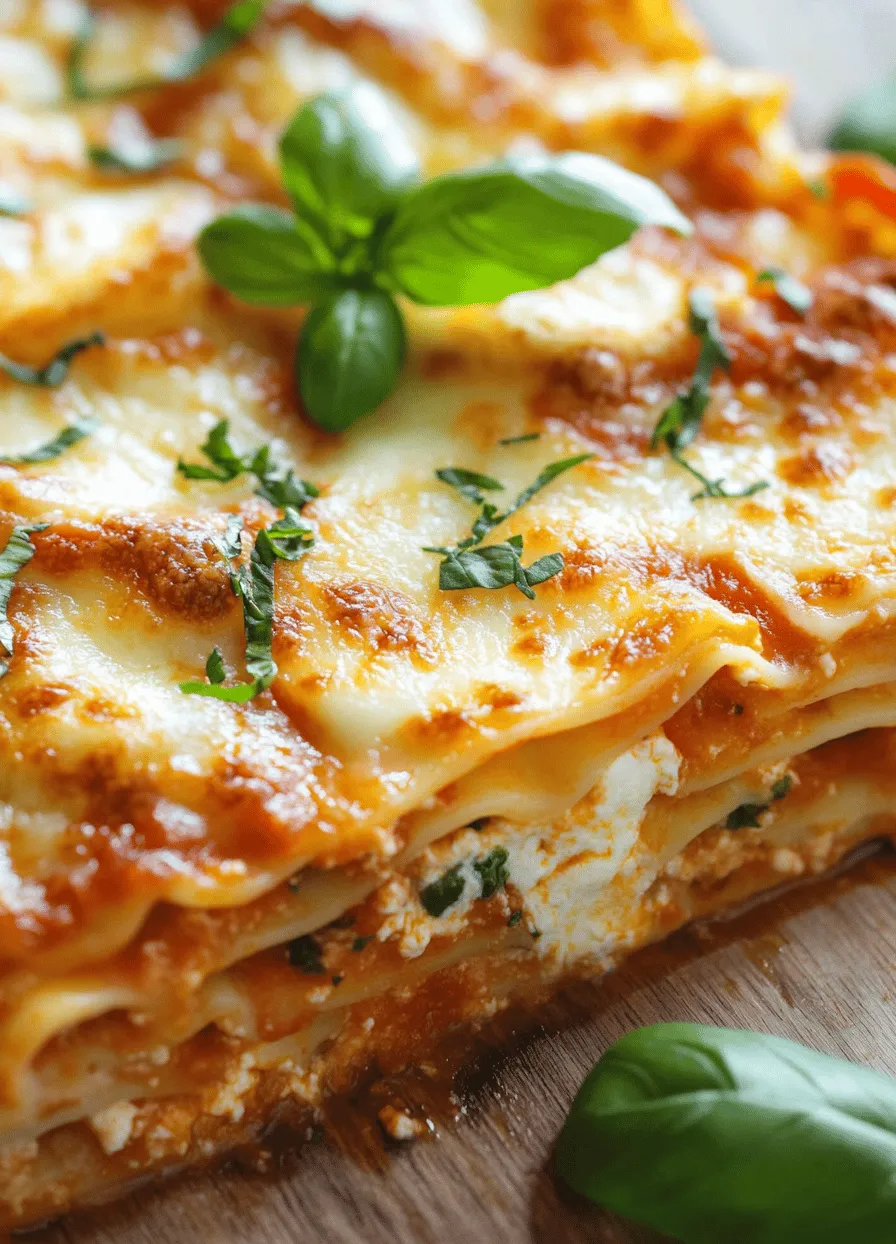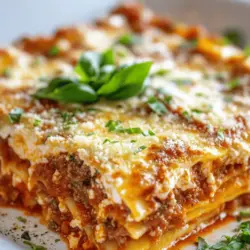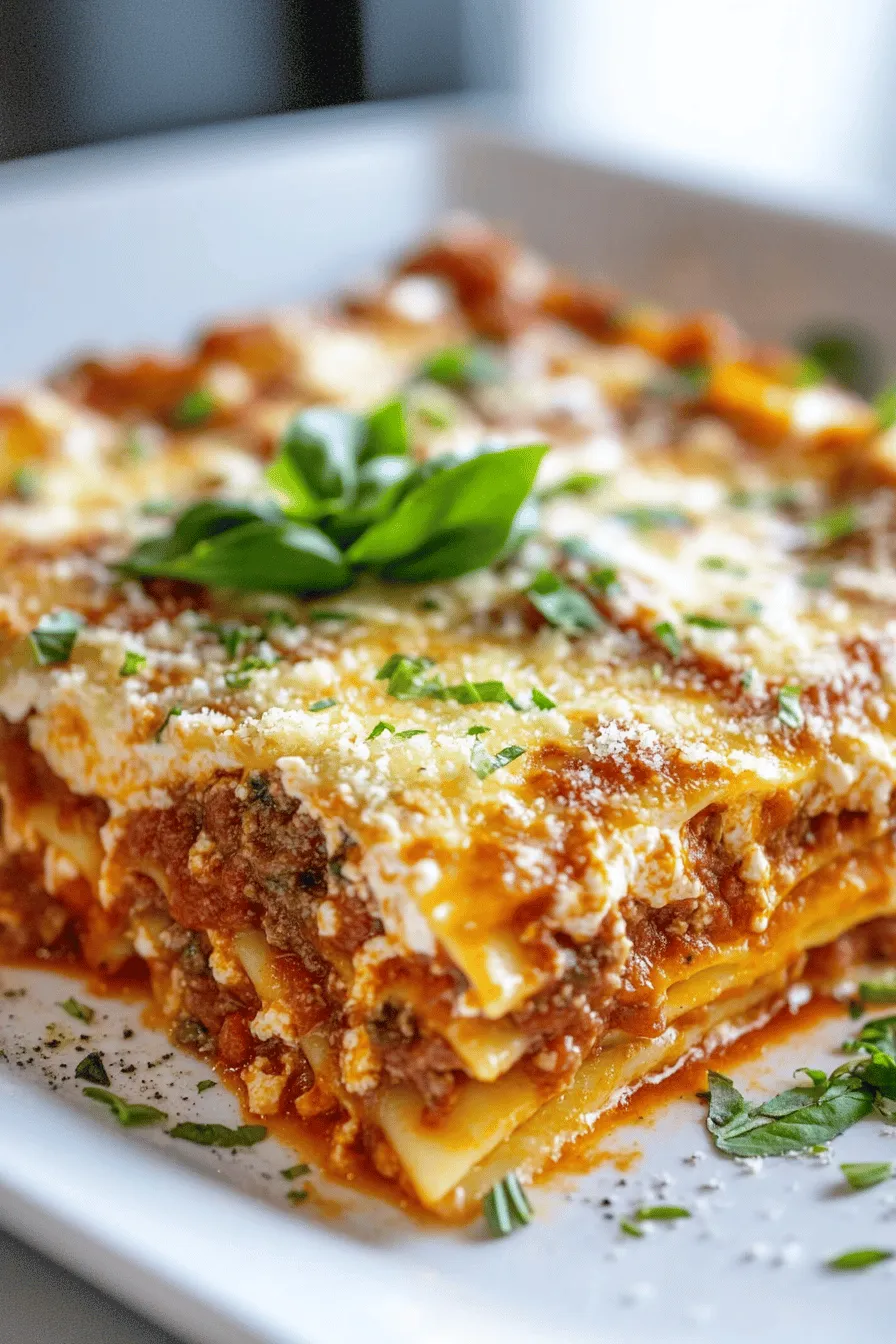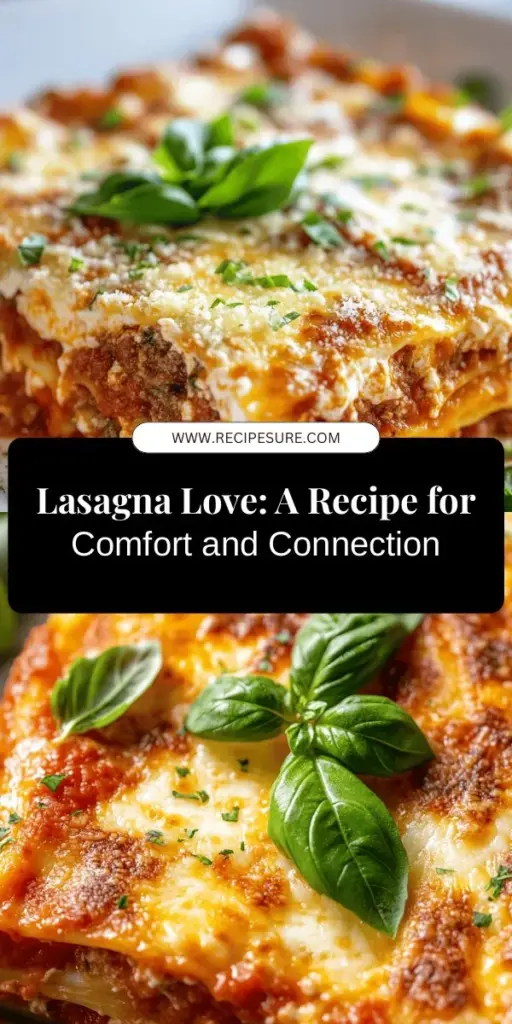Lasagna has long been a beloved comfort food, known for its rich layers of flavor and satisfying textures. This classic Italian dish combines pasta, cheese, and savory sauce, creating a hearty meal perfect for family gatherings or cozy nights in. With its warm, gooey layers and inviting aroma, lasagna has a unique ability to bring people together around the dinner table, making it a staple in many households. In this article, we will explore a delightful recipe for Lasagna Love, offering both a step-by-step guide to crafting this dish and insights into its cultural significance, variations, and nutritional value. Whether you’re a seasoned chef or a beginner in the kitchen, this guide is designed to help you create a lasagna that will warm your heart and fill your home with enticing aromas.
Understanding Lasagna: A Cultural Overview
The Origins of Lasagna
Lasagna has a rich history that dates back centuries, deeply rooted in Italian cuisine. The word “lasagna” is derived from the Greek word “laganon,” which refers to a dish made with layers of pasta. This dish evolved over time, with early versions appearing in Ancient Greece and later in Roman cuisine. It is believed that the first true lasagna, as we know it today, originated in the region of Emilia-Romagna, specifically in the city of Bologna.
In the Middle Ages, various layers of pasta were combined with sauces and cheeses, creating the foundation for modern lasagna. Over the years, the dish has seen numerous adaptations, with regional variations emerging throughout Italy. For instance, in Naples, lasagna is often made with a rich meat sauce, while in other regions, it may be prepared with vegetables or seafood. This evolution reflects not only the diverse agricultural practices across Italy but also the cultural influences that have shaped Italian cuisine over the centuries.
Lasagna in Popular Culture
Lasagna has made its mark in popular culture, often being depicted as a quintessential Italian dish in literature and film. One of the most famous representations is in the comic strip “Garfield,” where the titular cat expresses his love for lasagna, further cementing its status as a beloved comfort food. The dish’s hearty nature and versatility make it a frequent choice for family meals and special occasions.
In many households, lasagna plays a central role in family gatherings, celebrations, and holidays. It is often prepared in large quantities to feed a crowd, making it perfect for potlucks, birthdays, and festive dinners. The act of sharing a homemade lasagna is not just about the meal itself; it’s a way to connect with loved ones, share traditions, and create lasting memories. This cultural significance adds to the appeal of lasagna, making it more than just a dish, but a symbol of togetherness and love.
Ingredients Breakdown
Essential Ingredients for Lasagna
To create a delicious lasagna, it’s essential to choose the right ingredients. Each component plays a crucial role in achieving the perfect balance of flavors and textures.
Overview of Lasagna Noodles: Types and Selection
Lasagna noodles are the foundation of this dish, and there are several types available to choose from. Traditional lasagna noodles are wide, flat sheets of pasta that require boiling before assembly. However, no-boil or oven-ready noodles have become increasingly popular; these sheets can be layered directly into the dish without pre-cooking, saving time and effort.
When selecting your noodles, consider the thickness and texture. Thicker noodles may hold up better during cooking, while thinner ones can absorb sauce more effectively. Both options have their merits, so choose based on your personal preference and the desired texture of your lasagna.
Understanding Ricotta Cheese: Its Role and Alternatives
Ricotta cheese is a key ingredient in lasagna, contributing creaminess and richness to the dish. Its slightly sweet flavor complements the savory elements, making it indispensable in traditional recipes. When selecting ricotta, aim for a high-quality brand for the best results. If you’re looking for alternatives, cottage cheese or mascarpone can provide similar textures, though the flavor will vary slightly.
The Importance of Mozzarella and Parmesan Cheese
Mozzarella and Parmesan cheeses are essential in creating the gooey, flavorful layers that characterize lasagna. Mozzarella, with its melt-in-your-mouth creaminess, forms the top layer, creating a beautiful golden crust as it bakes. Fresh mozzarella is ideal, as it enhances the dish’s flavor and texture, but pre-shredded mozzarella can also do the job.
Parmesan cheese, with its sharp and nutty flavor, adds depth and richness to the dish. It is often incorporated into the layers or sprinkled on top before baking. For a more pronounced flavor, consider using aged Parmesan, which will provide an extra layer of complexity to your lasagna.
Herbs and Spices: Elevating the Flavor Profile
To truly elevate your lasagna, incorporating the right herbs and spices is essential. The significance of dried basil and oregano cannot be overstated; these herbs are often staples in Italian cuisine and complement the tomato sauce beautifully. Fresh herbs can also be used for a more vibrant flavor, but dried herbs are convenient and pack a punch in terms of taste.
Garlic powder is another critical ingredient that enhances the overall flavor profile of lasagna. It adds a savory depth that pairs well with the cheese and meat, creating a well-rounded dish. For an extra kick, consider fresh garlic or red pepper flakes, which can be adjusted to suit your spice tolerance.
Preparing the Perfect Lasagna
Prepping Your Ingredients
Before diving into the assembly of your lasagna, preparing your ingredients is crucial for a smooth cooking experience. Here are some tips for efficient ingredient preparation:
1. Gather All Ingredients: Ensure all your ingredients are within reach before you start cooking. This includes your noodles, cheeses, sauce, and any additional vegetables or meats you plan to include.
2. Measure and Organize: Accurate measurement of ingredients is key in achieving the desired taste and texture. Use measuring cups and spoons to portion out your ingredients, and keep them organized in bowls or containers. This will save you time and minimize mess as you layer your lasagna.
3. Prep Vegetables and Meats: If you are including vegetables or meats in your lasagna, make sure they are prepped ahead of time. Chop, slice, or brown any ingredients that need it before assembling the dish.
Step-by-Step Instructions
Now that you have all your ingredients prepared, it’s time to begin crafting your Lasagna Love. Follow these step-by-step instructions to ensure success:
1. Preheating the Oven: Why It Matters: Start by preheating your oven to the recommended temperature, typically around 375°F (190°C). Preheating is essential to ensure that your lasagna bakes evenly and achieves a perfect golden crust.
2. Crafting the Ricotta Filling: Texture and Consistency: In a mixing bowl, combine your ricotta cheese with an egg, a sprinkle of salt, and a generous handful of freshly grated Parmesan cheese. This mixture should be creamy yet firm, providing a delicious layer that won’t ooze out of your lasagna. Mix gently until well combined, ensuring a smooth consistency without over-mixing.
3. Building the Layers: Begin by spreading a thin layer of marinara sauce on the bottom of your baking dish. This will prevent the noodles from sticking and add flavor. Next, layer your first sheet of lasagna noodles, followed by half of the ricotta mixture, a layer of shredded mozzarella, and another layer of sauce. Repeat this process until you’ve used all your ingredients, finishing with a layer of noodles topped with sauce and a generous sprinkling of mozzarella and Parmesan cheese.
4. Baking the Lasagna: Cover the baking dish with aluminum foil to prevent the cheese from browning too quickly. Bake in the preheated oven for about 25-30 minutes. After this time, remove the foil and bake for an additional 15-20 minutes, or until the cheese is bubbling and golden brown.
By following these initial steps, you are well on your way to creating a delicious Lasagna Love that will be enjoyed by friends and family alike. In the next part of this article, we will dive deeper into tips for achieving the best results, as well as addressing common questions that arise when making lasagna. Stay tuned for more culinary insights and tricks to elevate your lasagna-making experience!

Layering Techniques for Optimal Flavor and Presentation
When it comes to assembling your lasagna, the layering technique is key to achieving both an appealing presentation and a burst of flavor in every bite. Here’s how to master the art of layering:
1. Start with Sauce: Begin by spreading a thin layer of your marinara sauce at the bottom of your baking dish. This not only prevents the noodles from sticking but also adds moisture to the base of your lasagna.
2. Noodle Placement: Place your first layer of lasagna noodles on top of the sauce. Ensure they are slightly overlapping to create a solid base. If you’re using no-boil noodles, they will expand during the baking process, so they can be placed closer together.
3. Add Filling: On top of the noodles, spread a generous layer of your ricotta cheese mixture, followed by a sprinkle of mozzarella cheese. Don’t skimp—this is where much of the flavor comes from. You can also add cooked vegetables, meat, or any other fillings you prefer.
4. Repeat Layers: Continue to layer the ingredients in the same order: sauce, noodles, ricotta mixture, mozzarella, and any additional fillings. Aim for at least three layers, but you can create more if your dish can accommodate it. Ensure the top layer ends with mozzarella and a sprinkle of Parmesan for that golden, bubbly crust.
5. Final Touches: Before baking, you can drizzle a bit of olive oil over the top layer for extra flavor. It also helps in browning the cheese beautifully.
Baking and Serving Lasagna
The Baking Process
Now that your lasagna is assembled, it’s time to bake it to perfection.
- Covering vs. Uncovering: Many recipes suggest covering lasagna with aluminum foil during the first half of the baking process to prevent the cheese from burning. After about 30 minutes, remove the foil to allow the cheese to brown and develop that coveted crust. If you prefer a softer top, you can leave it covered for the entire baking duration, but uncovering will yield a more appealing texture.
- Ideal Baking Times and Temperatures: Preheat your oven to 375°F (190°C). Bake your lasagna for approximately 45 minutes to an hour. If you’ve made a deep lasagna with multiple layers, it may take longer. A good indicator that it’s done is when the cheese is bubbly and golden brown, and the edges of the lasagna are starting to pull away from the sides of the dish.
Cooling and Slicing
Once your lasagna is out of the oven, patience is key.
- Why Resting is Crucial for Lasagna: Allow your lasagna to cool for at least 15 to 30 minutes before slicing. This resting time allows the layers to set, making it easier to cut and serve. If you slice too soon, the layers may slide apart, leading to a messy presentation.
- Techniques for Slicing Without Losing Layers: Use a sharp knife to slice through the lasagna. A serrated knife works well for cutting through the cheese and noodles. For perfectly shaped pieces, wipe the knife clean between cuts to prevent the layers from sticking to the blade.
Nutritional Value and Serving Suggestions
Understanding the Nutritional Content
As delicious as lasagna is, it’s also important to be mindful of its nutritional profile.
- Breakdown of Calories, Protein, and Fat per Serving: A typical serving of traditional meat lasagna contains about 300-400 calories, 20-25 grams of protein, and 15-25 grams of fat, depending on the ingredients used. Vegetarian versions may have fewer calories and fat, while maintaining a good protein level from cheese and other fillings.
- How to Balance Lasagna with Side Dishes for a Complete Meal: To create a well-rounded meal, consider serving your lasagna with a side salad or steamed vegetables. This adds fiber and nutrients to your meal while balancing the richness of the lasagna.
Pairing Suggestions
Enhancing your lasagna meal with complementary sides and beverages can elevate the dining experience.
- Recommended Salads and Sides to Complement Lasagna: A classic Caesar salad or mixed greens with a light vinaigrette pairs wonderfully with lasagna. The freshness of the salad cuts through the richness of the dish, providing a refreshing contrast. Garlic bread is another favorite side, perfect for soaking up any leftover sauce.
- Ideal Beverages to Accompany Your Meal: For beverages, a glass of red wine, like Chianti or Merlot, complements the flavors of the lasagna beautifully. If you prefer non-alcoholic options, sparkling water with a slice of lemon or a light fruit punch can be refreshing choices.
Lasagna Variations and Adaptations
Lasagna is incredibly versatile, allowing for numerous variations that cater to different dietary preferences and cultural influences.
Exploring Alternative Ingredients
- Vegetarian and Vegan Adaptations for Lasagna: For a vegetarian version, consider using layers of sautéed vegetables like zucchini, mushrooms, and spinach in place of meat. If you’re looking for a vegan option, substitute ricotta with silken tofu blended with nutritional yeast, lemon juice, and garlic powder, and use vegan cheese.
- Gluten-Free Options: Noodles and Sauces: Gluten-free lasagna noodles are widely available, made from rice, corn, or quinoa. You can also make your own from vegetables, like thinly sliced zucchini or eggplant, as a nutritious alternative.
Regional Variations of Lasagna
Lasagna’s popularity has led to a variety of regional adaptations around the world.
- Differences in Lasagna Styles Across Italy and Beyond: In Italy, the classic Lasagna alla Bolognese features layers of rich meat sauce and béchamel, while in Naples, a more rustic version may include ricotta and mozzarella. Beyond Italy, you can find inventive twists, such as Mexican lasagna made with tortillas and salsa.
- Unique Twists and Spins on the Classic Recipe: Create a Mediterranean-inspired lasagna with layers of feta, olives, and roasted red peppers for a refreshing change. Alternatively, experiment with Asian flavors by incorporating teriyaki chicken and vegetables, using rice noodles in place of traditional lasagna noodles.
Conclusion
Lasagna Love is more than just a recipe; it’s a celebration of flavors and traditions that bring people together. This timeless dish offers endless possibilities for customization, making it a versatile choice for any occasion. With a clear understanding of the ingredients and techniques involved, you can create a lasagna that not only satisfies your hunger but also captures the essence of comfort food.
Embrace the joy of cooking and share in the love of lasagna with family and friends, creating memories that will last a lifetime. Whether you stick to the classic recipe or explore new variations, the love poured into each layer will surely make your lasagna a cherished favorite among all who gather around your table.


